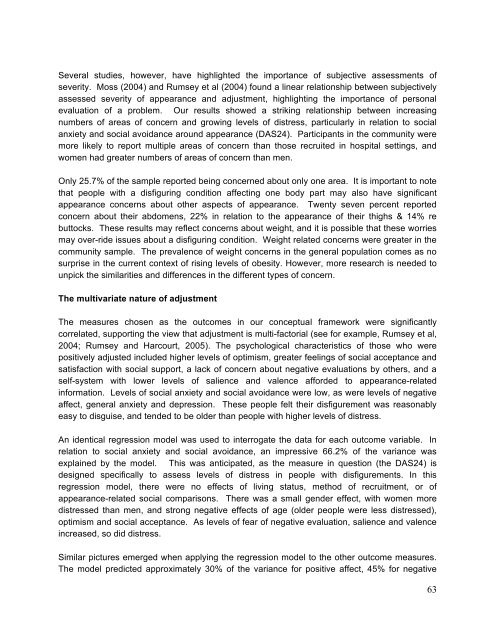Download the report - The Healing Foundation
Download the report - The Healing Foundation
Download the report - The Healing Foundation
You also want an ePaper? Increase the reach of your titles
YUMPU automatically turns print PDFs into web optimized ePapers that Google loves.
Several studies, however, have highlighted <strong>the</strong> importance of subjective assessments of<br />
severity. Moss (2004) and Rumsey et al (2004) found a linear relationship between subjectively<br />
assessed severity of appearance and adjustment, highlighting <strong>the</strong> importance of personal<br />
evaluation of a problem. Our results showed a striking relationship between increasing<br />
numbers of areas of concern and growing levels of distress, particularly in relation to social<br />
anxiety and social avoidance around appearance (DAS24). Participants in <strong>the</strong> community were<br />
more likely to <strong>report</strong> multiple areas of concern than those recruited in hospital settings, and<br />
women had greater numbers of areas of concern than men.<br />
Only 25.7% of <strong>the</strong> sample <strong>report</strong>ed being concerned about only one area. It is important to note<br />
that people with a disfiguring condition affecting one body part may also have significant<br />
appearance concerns about o<strong>the</strong>r aspects of appearance. Twenty seven percent <strong>report</strong>ed<br />
concern about <strong>the</strong>ir abdomens, 22% in relation to <strong>the</strong> appearance of <strong>the</strong>ir thighs & 14% re<br />
buttocks. <strong>The</strong>se results may reflect concerns about weight, and it is possible that <strong>the</strong>se worries<br />
may over-ride issues about a disfiguring condition. Weight related concerns were greater in <strong>the</strong><br />
community sample. <strong>The</strong> prevalence of weight concerns in <strong>the</strong> general population comes as no<br />
surprise in <strong>the</strong> current context of rising levels of obesity. However, more research is needed to<br />
unpick <strong>the</strong> similarities and differences in <strong>the</strong> different types of concern.<br />
<strong>The</strong> multivariate nature of adjustment<br />
<strong>The</strong> measures chosen as <strong>the</strong> outcomes in our conceptual framework were significantly<br />
correlated, supporting <strong>the</strong> view that adjustment is multi-factorial (see for example, Rumsey et al,<br />
2004; Rumsey and Harcourt, 2005). <strong>The</strong> psychological characteristics of those who were<br />
positively adjusted included higher levels of optimism, greater feelings of social acceptance and<br />
satisfaction with social support, a lack of concern about negative evaluations by o<strong>the</strong>rs, and a<br />
self-system with lower levels of salience and valence afforded to appearance-related<br />
information. Levels of social anxiety and social avoidance were low, as were levels of negative<br />
affect, general anxiety and depression. <strong>The</strong>se people felt <strong>the</strong>ir disfigurement was reasonably<br />
easy to disguise, and tended to be older than people with higher levels of distress.<br />
An identical regression model was used to interrogate <strong>the</strong> data for each outcome variable. In<br />
relation to social anxiety and social avoidance, an impressive 66.2% of <strong>the</strong> variance was<br />
explained by <strong>the</strong> model. This was anticipated, as <strong>the</strong> measure in question (<strong>the</strong> DAS24) is<br />
designed specifically to assess levels of distress in people with disfigurements. In this<br />
regression model, <strong>the</strong>re were no effects of living status, method of recruitment, or of<br />
appearance-related social comparisons. <strong>The</strong>re was a small gender effect, with women more<br />
distressed than men, and strong negative effects of age (older people were less distressed),<br />
optimism and social acceptance. As levels of fear of negative evaluation, salience and valence<br />
increased, so did distress.<br />
Similar pictures emerged when applying <strong>the</strong> regression model to <strong>the</strong> o<strong>the</strong>r outcome measures.<br />
<strong>The</strong> model predicted approximately 30% of <strong>the</strong> variance for positive affect, 45% for negative<br />
63


